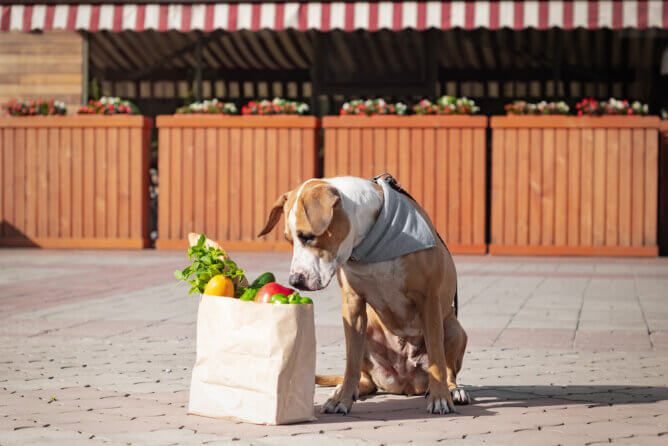Will Dog Food Ever Be Meat-Free?

Where a meat-free dog diet was once considered barking mad, it’s fast becoming something that many pet parents will choose — or need — to adopt for their dog.
For health or environmental reasons, people are reducing their own meat intake. An estimated 14% of the US population now follows a meat-free lifestyle. And, as the number of vegan and vegetarian consumers increases, more people are seeking meat-free alternatives for their dogs.
However, unlike humans, who can make their own dietary choices, dogs depend on their pet parents to provide balanced and complete meals — and protein is an essential nutrient for dogs. So how can people feed their dogs properly without meat?
Well, advances in science are making meat-free dog food a viable, sustainable and potentially affordable option for the not-too-distant future.
But how will it shape up? Here are three likely sources:
Plant-Based Protein
Plant-based food for dogs, surely not? Picturing dogs’ wolverine ancestors enjoying a soy supper does seem outrageous.
But dogs have evolved. In fact, dogs are omnivores, which means it is possible for them to get their essential nutrients from a meatless diet, just like humans.
Protein-rich plant foods such as soy, peas, lentils, and quinoa can provide the necessary amino acids to support canine muscle development and overall health.
Aside from being a great protein source, these meat alternatives are also packed with dietary fiber and contain essential vitamins and minerals. Such plant-based proteins have emerged as an alternative to traditional meat sources in various dog foods.
However, the best vegan dog food should be carefully selected and commercially made (rather than a vegan blend you make at home).1 It must contain a healthy balance of protein, vitamins and minerals derived from sources other than meat; and meets the standards of the Association of American Feed Control Officials (AAFCO).
For people who are interested in feeding their furry friends a vegan diet that aligns with their personal values, choosing a vegan dog food that contains a plant-based protein is, in theory, an ideal choice.
However, there have been some concerns about whether existing vegan dog food contains as much nutritional value as traditional meat foods.2
Therefore, it is essential to consult with your vet before opting for a vegan food as all dogs are unique and this may or may not be a suitable option for your pet.
Insect-Based Proteins
Some people cringe at the sight of cockroaches, others welcome them as an appetizer.
Insects have been part of human diets in many cultures for centuries, and now with the rising population and environmental concerns, insect-eating is likely to go mainstream across the world.
Insect farming emits fewer greenhouse gases than farming animals for slaughter, making insects a planet-friendly — and potentially cheaper — protein source.3
Insects offer a diverse nutritional composition, including essential nutrients like iron, calcium, and vitamin B12, in addition to protein. The essential amino acids found in crickets, for example, are comparable to those in eggs, chicken, pork, and beef, which are the main protein sources in the typical dog diet.4
But is it safe to feed my dog insects?
Currently, the black soldier fly is the most promising insect protein according to scientific research. The black soldier fly has received approval from the Association of American Feed Controls (AAFCO) as a safe species to include in dog food and treats.5 It provides all ten essential amino acids crucial for a dog’s healthy growth and development, including arginine, which supports cardiovascular health.6
Insect-based food not only boasts high protein content but also serves as a hypoallergenic alternative, reducing the risk of allergic reactions, making it a great option for dogs with sensitivities.7
Although the idea of eating crickets and flies may not sound appealing, dogs are likely to be less fussy and there are already insect-based dog foods sold in several countries, including the United Kingdom, Switzerland, Germany, and Denmark.
Lab-Grown Meat
Also known as cultivated meat, this option has gone from science-fiction to hyper-expensive to market-ready in the past decade.
This space-age protein eliminates the need for animal farming and requires fewer natural resources. Primarily made from muscle cells from living animals, it could be a more ethical, sustainable protein option for the future.8
But hold your hounds. While the technology is promising, lab-grown meat is still in its early stages of development and not yet widely available for pet consumption. Some pet food companies such as Bond Pet Foods and Because, Animals have been experimenting with cultivated meat but there are still challenges associated with this process including the taste, texture, and nutritional value.
So, as research progresses and regulations loosen their collars, this cosmic cuisine might just become your dog’s next favorite protein.
Changing to meat-free dog food
Right now, meat-free dog foods are in their infancy but with environmental and cost concerns, they could become major parts of the market.
If you are considering a meat-free diet for your furry companion, it’s important to bear in mind transitioning between different types of foods should be done gradually.
Have a conversation with your vet to ensure your dog is suited to a meat-free diet and if you have the go-ahead, gradually introduce the new lifestyle.
Start by mixing a small portion of the new food into the old mix and slowly increase the size for the next few weeks.
This way your dog’s insides will get used to the new meat-free diet without going cold turkey!


